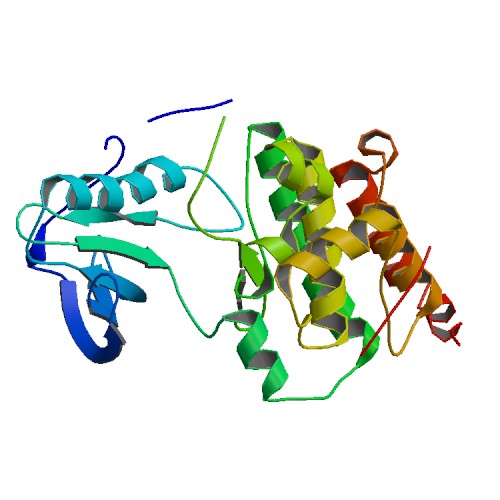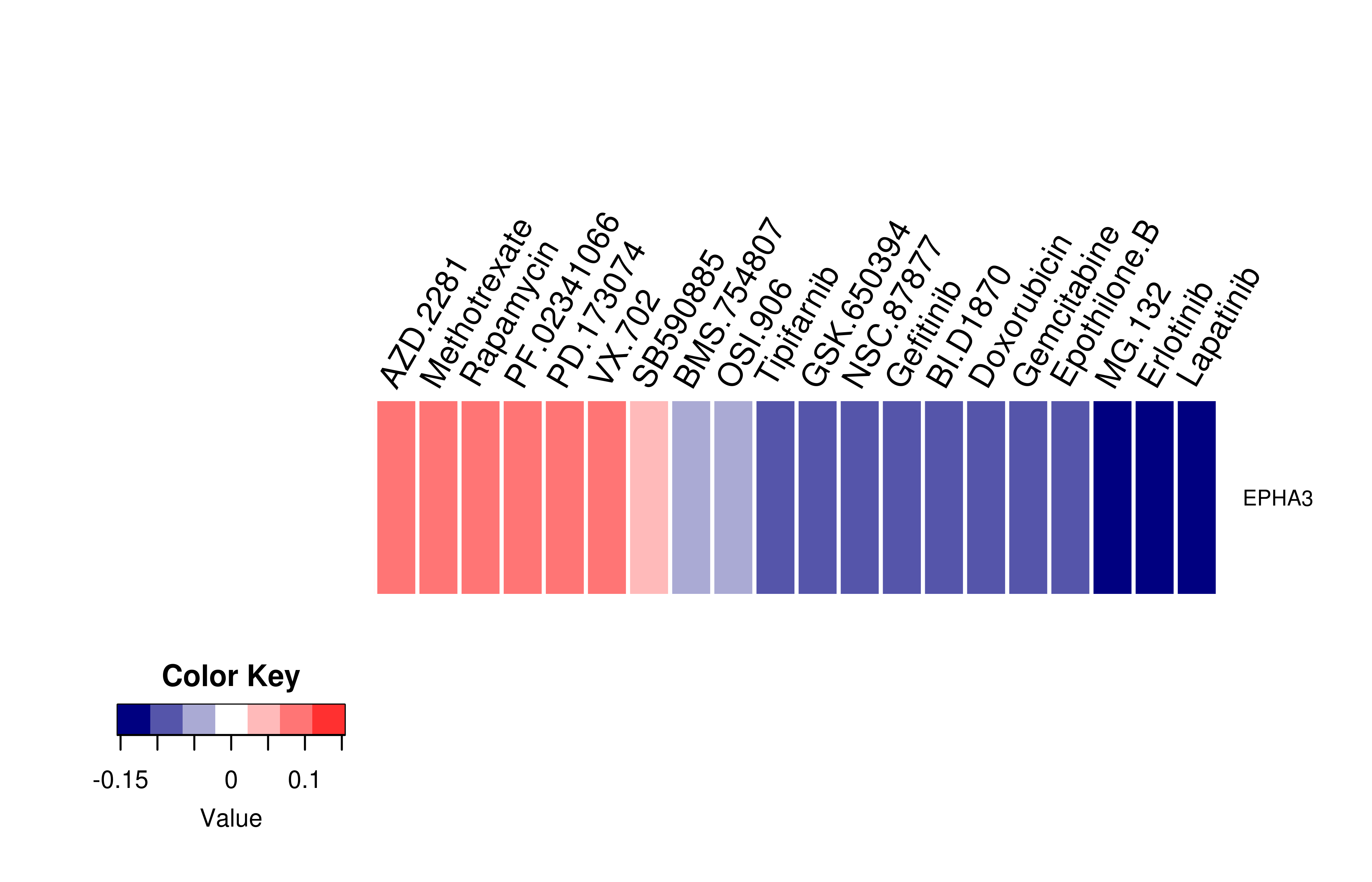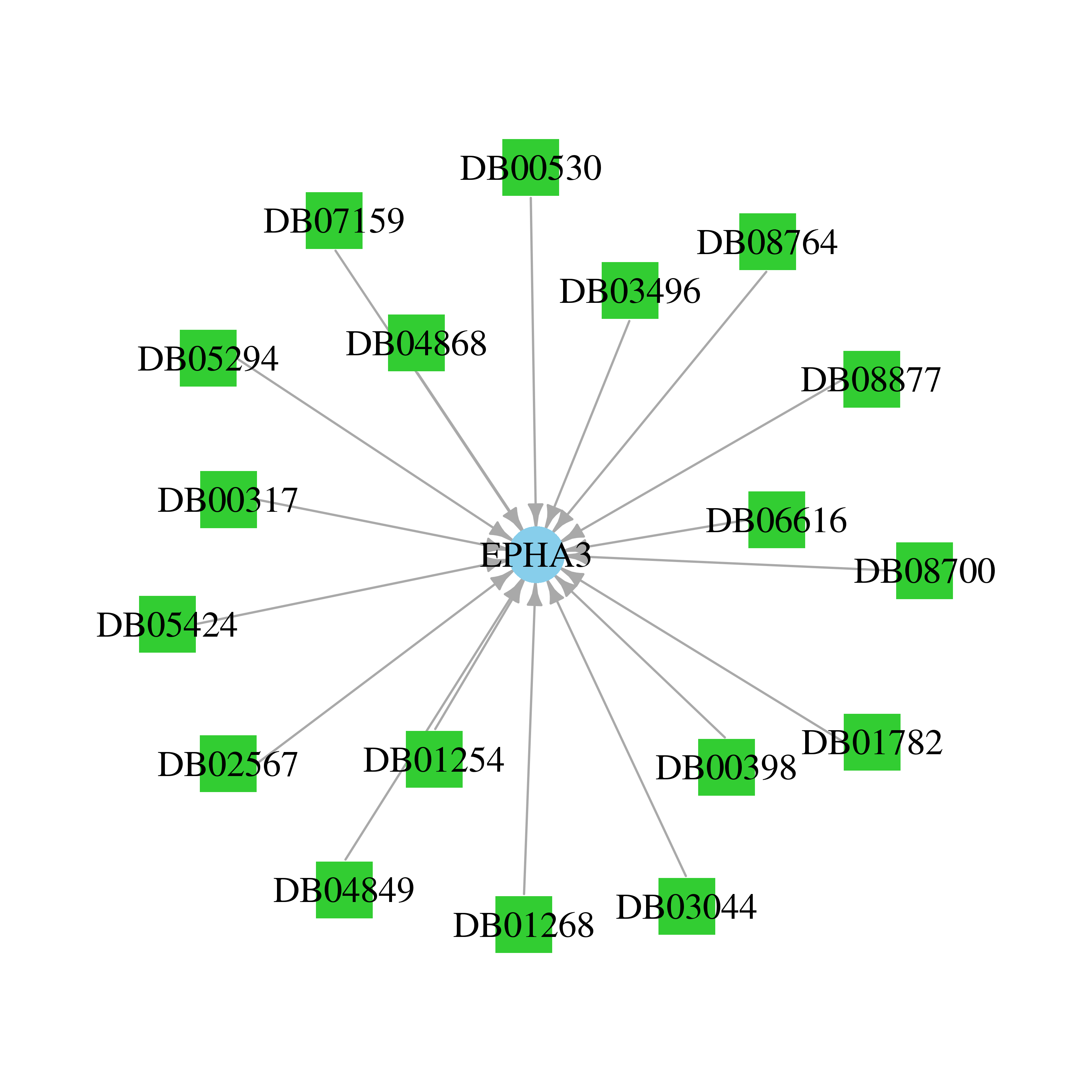|
mutLBSgeneDB |
| |
| |
| |
| |
| |
| |
|
| Gene summary for EPHA3 |
 Gene summary Gene summary |
| Basic gene Info. | Gene symbol | EPHA3 |
| Gene name | EPH receptor A3 | |
| Synonyms | EK4|ETK|ETK1|HEK|HEK4|TYRO4 | |
| Cytomap | UCSC genome browser: 3p11.2 | |
| Type of gene | protein-coding | |
| RefGenes | NM_005233.5, NM_182644.2, | |
| Description | EPH-like kinase 4TYRO4 protein tyrosine kinaseeph-like tyrosine kinase 1ephrin type-A receptor 3human embryo kinase 1tyrosine-protein kinase receptor ETK1 | |
| Modification date | 20141207 | |
| dbXrefs | MIM : 179611 | |
| HGNC : HGNC | ||
| Ensembl : ENSG00000044524 | ||
| HPRD : 01555 | ||
| Vega : OTTHUMG00000159040 | ||
| Protein | UniProt: P29320 go to UniProt's Cross Reference DB Table | |
| Expression | CleanEX: HS_EPHA3 | |
| BioGPS: 2042 | ||
| Pathway | NCI Pathway Interaction Database: EPHA3 | |
| KEGG: EPHA3 | ||
| REACTOME: EPHA3 | ||
| Pathway Commons: EPHA3 | ||
| Context | iHOP: EPHA3 | |
| ligand binding site mutation search in PubMed: EPHA3 | ||
| UCL Cancer Institute: EPHA3 | ||
| Assigned class in mutLBSgeneDB | B: This gene belongs to targetable_mutLBSgenes. | |
 Gene ontology having evidence of Inferred from Direct Assay (IDA) from Entrez Gene ontology having evidence of Inferred from Direct Assay (IDA) from Entrez |
| GO ID | GO Term | PubMed ID | GO:0032319 | regulation of Rho GTPase activity | 11870224 | GO:0032956 | regulation of actin cytoskeleton organization | 11870224 | GO:0048013 | ephrin receptor signaling pathway | 11870224 | GO:0051893 | regulation of focal adhesion assembly | 11870224 | GO:0070507 | regulation of microtubule cytoskeleton organization | 11870224 |
| Top |
| Ligand binding site mutations for EPHA3 |
 Lollipop-style diagram of mutations at LBS in amino-acid sequence. Lollipop-style diagram of mutations at LBS in amino-acid sequence. We represented ligand binding site mutations only. (You can see big image via clicking.) |
 |
 Cancer type specific mutLBS sorted by frequency Cancer type specific mutLBS sorted by frequency |
| LBS | AAchange of nsSNV | Cancer type | # samples | D746 | D746N | SKCM | 2 | R750 | R750Q | COAD | 1 | Y742 | G741D | COAD | 1 | A651 | A651T | COAD | 1 | I683 | R684P | COAD | 1 | S763 | K761R | COAD | 1 | F765 | G766V | COAD | 1 | F677 | F677Y | GBM | 1 | V635 | V635L | HNSC | 1 | S763 | K761N | LUAD | 1 | E670 | L668Q | LUAD | 1 | N830 | D832Y | LUAD | 1 | R750 | R750L | LUAD | 1 | K653 | K653R | LUAD | 1 | E700 | E700K | SKCM | 1 | S763 | K761M | STAD | 1 | K625 | K625T | STAD | 1 | E670 | L668M | UCEC | 1 | R750 | R750Q | UCEC | 1 | A651 | A651V | UCEC | 1 |
| cf) Cancer type abbreviation. BLCA: Bladder urothelial carcinoma, BRCA: Breast invasive carcinoma, CESC: Cervical squamous cell carcinoma and endocervical adenocarcinoma, COAD: Colon adenocarcinoma, GBM: Glioblastoma multiforme, LGG: Brain lower grade glioma, HNSC: Head and neck squamous cell carcinoma, KICH: Kidney chromophobe, KIRC: Kidney renal clear cell carcinoma, KIRP: Kidney renal papillary cell carcinoma, LAML: Acute myeloid leukemia, LUAD: Lung adenocarcinoma, LUSC: Lung squamous cell carcinoma, OV: Ovarian serous cystadenocarcinoma, PAAD: Pancreatic adenocarcinoma, PRAD: Prostate adenocarcinoma, SKCM: Skin cutaneous melanoma, STAD: Stomach adenocarcinoma, THCA: Thyroid carcinoma, UCEC: Uterine corpus endometrial carcinoma. |
 Clinical information for EPHA3 from My Cancer Genome. Clinical information for EPHA3 from My Cancer Genome. |
| EPH receptor A3 (EPHA3) is a gene that encodes a protein-tyrosine kinase in the ephrin receptor family. Missense mutations, nonsense mutations, silent mutations, and frameshift deletions are observed in cancers such as esophageal cancer, intestinal cancer, and stomach cancer. Related Pathways: Receptor tyrosine kinase/growth factor signaling. Modified: December 4, 2015 |
| Top |
| Protein structure related information for EPHA3 |
 Relative protein structure stability change (ΔΔE) using Mupro 1.1 Relative protein structure stability change (ΔΔE) using Mupro 1.1 Mupro score denotes assessment of the effect of mutations on thermodynamic stability. (ΔΔE<0: mutation decreases stability, ΔΔE>0: mutation increases stability) |
 : nsSNV at non-LBS : nsSNV at non-LBS : nsSNV at LBS : nsSNV at LBS |
 |
 nsSNVs sorted by the relative stability change of protein structure by each mutation nsSNVs sorted by the relative stability change of protein structure by each mutation Blue: mutations of positive stability change. and red : the most recurrent mutation for this gene. |
| LBS | AAchange of nsSNV | Relative stability change | K653 | K653R | 0.14384279 | E670 | L668Q | -1.2373015 | I683 | R684P | -1.2212311 | Y742 | G741D | -1.1284954 | S763 | K761N | -1.0693767 | K625 | K625T | -0.99363234 | E700 | E700K | -0.8854562 | E670 | L668M | -0.88194542 | D746 | D746N | -0.85200257 | R750 | R750Q | -0.84069406 | N830 | D832Y | -0.66875279 | A651 | A651T | -0.65247374 | S763 | K761R | -0.64619996 | F677 | F677Y | -0.63171984 | F765 | G766V | -0.60567504 | S763 | K761M | -0.59905394 | V635 | V635L | -0.43559422 | A651 | A651V | -0.35633275 | R750 | R750L | -0.29653557 |
| (MuPro1.1: Jianlin Cheng et al., Prediction of Protein Stability Changes for Single-Site Mutations Using Support Vector Machines, PROTEINS: Structure, Function, and Bioinformatics. 2006, 62:1125-1132) |
 Structure image for EPHA3 from PDB Structure image for EPHA3 from PDB |
| PDB ID | PDB title | PDB structure | 2GSF | The Human Epha3 Receptor Tyrosine Kinase and Juxtamembrane Region |  |
| Top |
| Differential gene expression and gene-gene network for EPHA3 |
 Differential gene expression between mutated and non-mutated LBS samples in all 16 major cancer types Differential gene expression between mutated and non-mutated LBS samples in all 16 major cancer types |
 Differential co-expressed gene network based on protein-protein interaction data (CePIN) Differential co-expressed gene network based on protein-protein interaction data (CePIN) |
| Top |
| Top |
| Phenotype information for EPHA3 |
 Gene level disease information (DisGeNet) Gene level disease information (DisGeNet) |
| Disease ID | Disease name | # PubMed | Association type |
 Mutation level pathogenic information (ClinVar annotation) Mutation level pathogenic information (ClinVar annotation) |
| Allele ID | AA change | Clinical significance | Origin | Phenotype IDs |
| Top |
| Pharmacological information for EPHA3 |
 Gene expression profile of anticancer drug treated cell-lines (CCLE) Gene expression profile of anticancer drug treated cell-lines (CCLE)Heatmap showing the correlation between gene expression and drug response across all the cell-lines. We chose the top 20 among 138 drugs.We used Pearson's correlation coefficient. |
 |
 Gene-centered drug-gene interaction network Gene-centered drug-gene interaction network |
 |
 Drug information targeting mutLBSgene (Approved drugs only) Drug information targeting mutLBSgene (Approved drugs only) |
| Drug status | DrugBank ID | Name | Type | Drug structure |
 Gene-centered ligand-gene interaction network Gene-centered ligand-gene interaction network |
 |
 Ligands binding to mutated ligand binding site of EPHA3 go to BioLip Ligands binding to mutated ligand binding site of EPHA3 go to BioLip |
| Ligand ID | Ligand short name | Ligand long name | PDB ID | PDB name | mutLBS | ANP | AMP-PNP | 2qoq | A | A651 E700 | ANP | AMP-PNP | 2qoc | A | A651 E700 R750 | C07 | 1-AMINO-5-(5-HYDROXY-2-METHYLPHENYL)-7,8,9,10- TETRAHYDROPYRIMIDO[4,5-C]ISOQUINOLIN-6(5H)-ONE | 4g2f | A | A651 K653 E670 E700 S763 | L90 | 8-BUTYL-1-METHYL-7-(5-METHYL-1H-INDAZOL-4-YL)-1H- IMIDAZO[2,1-F]PURINE-2,4(3H,8H)-DIONE | 4gk4 | A | A651 K653 E670 E700 S763 | IFC | N-(2-METHYL-5-(3-(4-METHYL-1H-IMIDAZOL-1-YL)-5-(TRIFLUOROMETHYL)BENZAMIDO)PHENYL)ISOXAZOLE-5-CARBOXAMIDE | 3dzq | A | A651 K653 E670 F677 I683 Y742 S763 F765 | L87 | 8-BUTYL-1-METHYL-7-(2-METHYLPHENYL)-1H-IMIDAZO[2,1- F]PURINE-2,4(3H,8H)-DIONE | 4gk3 | A | A651 K653 E670 S763 | ANP | AMP-PNP | 2qo7 | A | A651 K653 E700 | III | Peptide ligand (GLN,TRP,ASP,ASN,TYR,GLU,TYR,ILE,TRP) | 3fxx | A | D746 R750 N830 | III | Peptide ligand (TRP,ASP,ASN,TYR,GLU,PHE,ILE,TRP) | 3fy2 | A | D746 R750 N830 | 37W | 5-{[3-CARBAMOYL-4-(3,4-DIMETHYLPHENYL)-5- METHYLTHIOPHEN-2-YL]AMINO}-5-OXOPENTANOIC ACID | 4two | A | K625 A651 K653 E700 | MG | MAGNESIUM(2+) | 2qoc | A | R750 | ANP | AMP-PNP | 2qo9 | A | V635 A651 E700 | ANP | AMP-PNP | 3fxx | A | V635 A651 E700 | Q7M | 2-AMINO-1-[4-({[3-(TRIFLUOROMETHYL) PHENYL]CARBAMOYL}AMINO)PHENYL]-1H-PYRROLO[2,3- B]QUINOXALINE-3-CARBOXAMIDE | 4p5z | A | V635 A651 K653 E670 F677 I683 E700 Y742 S763 F765 | L66 | 7-(5-HYDROXY-2-METHYLPHENYL)-8-(2-METHOXYPHENYL)-1- METHYL-1H-IMIDAZO[2,1-F]PURINE-2,4(3H,8H)-DIONE | 4gk2 | A | V635 A651 K653 E670 R750 S763 | Q0B | 2-AMINO-1-(2-CHLOROPHENYL)-N-(3-ETHOXYPROPYL)-1H- PYRROLO[2,3-B]QUINOXALINE-3-CARBOXAMIDE | 4p5q | A | V635 A651 K653 E700 S763 | B96 | 1-(5-TERT-BUTYL-2-P-TOLYL-2H-PYRAZOL-3-YL)-3-[4-(2-MORPHOLIN-4-YL-ETHOXY)-NAPHTHALEN-1-YL]-UREA | 4twn | A | V635 K653 E670 F677 I683 Y742 S763 F765 |
| Top |
| Conservation information for LBS of EPHA3 |
 Multiple alignments for P29320 in multiple species Multiple alignments for P29320 in multiple species |
| LBS | AA sequence | # species | Species | A629 | DKVVGAGEFGE | 3 | Homo sapiens, Gallus gallus, Rattus norvegicus | A651 | KEISVAIKTLK | 3 | Homo sapiens, Gallus gallus, Rattus norvegicus | D746 | GYVHRDLAARN | 3 | Homo sapiens, Gallus gallus, Rattus norvegicus | D764 | VCKVSDFGLSR | 3 | Homo sapiens, Gallus gallus, Rattus norvegicus | E631 | VVGAGEFGEVC | 3 | Homo sapiens, Gallus gallus, Rattus norvegicus | E670 | RDFLGEASIMG | 3 | Homo sapiens, Gallus gallus, Rattus norvegicus | E700 | VMIVTEYMENG | 3 | Homo sapiens, Gallus gallus, Rattus norvegicus | E703 | VTEYMENGSLD | 3 | Homo sapiens, Gallus gallus, Rattus norvegicus | F632 | VGAGEFGEVCS | 3 | Homo sapiens, Gallus gallus, Rattus norvegicus | F677 | SIMGQFDHPNI | 3 | Homo sapiens, Gallus gallus, Rattus norvegicus | F765 | CKVSDFGLSRV | 3 | Homo sapiens, Gallus gallus, Rattus norvegicus | G628 | IDKVVGAGEFG | 3 | Homo sapiens, Gallus gallus, Rattus norvegicus | G630 | KVVGAGEFGEV | 3 | Homo sapiens, Gallus gallus, Rattus norvegicus | G705 | EYMENGSLDSF | 3 | Homo sapiens, Gallus gallus, Rattus norvegicus | G784 | YTTRGGKIPIR | 2 | Homo sapiens, Gallus gallus | G784 | YTTRGGKIPVR | 1 | Rattus norvegicus | H744 | DMGYVHRDLAA | 3 | Homo sapiens, Gallus gallus, Rattus norvegicus | I673 | LGEASIMGQFD | 3 | Homo sapiens, Gallus gallus, Rattus norvegicus | I682 | FDHPNIIRLEG | 3 | Homo sapiens, Gallus gallus, Rattus norvegicus | I683 | DHPNIIRLEGV | 3 | Homo sapiens, Gallus gallus, Rattus norvegicus | I697 | SKPVMIVTEYM | 3 | Homo sapiens, Gallus gallus, Rattus norvegicus | I786 | TRGGKIPIRWT | 2 | Homo sapiens, Gallus gallus | I786 | TRGGKIPVRWT | 1 | Rattus norvegicus | I788 | GGKIPIRWTSP | 2 | Homo sapiens, Gallus gallus | I788 | GGKIPVRWTSP | 1 | Rattus norvegicus | I796 | TSPEAIAYRKF | 2 | Homo sapiens, Gallus gallus | I796 | TSPEATAYRKF | 1 | Rattus norvegicus | K625 | NISIDKVVGAG | 2 | Homo sapiens, Gallus gallus | K625 | NIAIDKVVGAG | 1 | Rattus norvegicus | K653 | ISVAIKTLKVG | 2 | Homo sapiens, Rattus norvegicus | K653 | ISVAIKTLKAG | 1 | Gallus gallus | K785 | TTRGGKIPIRW | 2 | Homo sapiens, Gallus gallus | K785 | TTRGGKIPVRW | 1 | Rattus norvegicus | L737 | SGMKYLSDMGY | 3 | Homo sapiens, Gallus gallus, Rattus norvegicus | L753 | AARNILINSNL | 3 | Homo sapiens, Gallus gallus, Rattus norvegicus | M674 | GEASIMGQFDH | 3 | Homo sapiens, Gallus gallus, Rattus norvegicus | M702 | IVTEYMENGSL | 3 | Homo sapiens, Gallus gallus, Rattus norvegicus | N704 | TEYMENGSLDS | 3 | Homo sapiens, Gallus gallus, Rattus norvegicus | N751 | DLAARNILINS | 3 | Homo sapiens, Gallus gallus, Rattus norvegicus | N830 | YWEMSNQDVIK | 2 | Homo sapiens, Rattus norvegicus | N830 | YWEMSFQDVIK | 1 | Gallus gallus | P787 | RGGKIPIRWTS | 2 | Homo sapiens, Gallus gallus | P787 | RGGKIPVRWTS | 1 | Rattus norvegicus | R750 | RDLAARNILIN | 3 | Homo sapiens, Gallus gallus, Rattus norvegicus | R823 | MSYGERPYWEM | 3 | Homo sapiens, Gallus gallus, Rattus norvegicus | S706 | YMENGSLDSFL | 3 | Homo sapiens, Gallus gallus, Rattus norvegicus | S763 | LVCKVSDFGLS | 3 | Homo sapiens, Gallus gallus, Rattus norvegicus | T699 | PVMIVTEYMEN | 3 | Homo sapiens, Gallus gallus, Rattus norvegicus | V627 | SIDKVVGAGEF | 2 | Homo sapiens, Gallus gallus | V627 | AIDKVVGAGEF | 1 | Rattus norvegicus | V635 | GEFGEVCSGRL | 3 | Homo sapiens, Gallus gallus, Rattus norvegicus | W790 | KIPIRWTSPEA | 2 | Homo sapiens, Gallus gallus | W790 | KIPVRWTSPEA | 1 | Rattus norvegicus | Y701 | MIVTEYMENGS | 3 | Homo sapiens, Gallus gallus, Rattus norvegicus | Y742 | LSDMGYVHRDL | 3 | Homo sapiens, Gallus gallus, Rattus norvegicus |
 |
Copyright © 2016-Present - The University of Texas Health Science Center at Houston |
